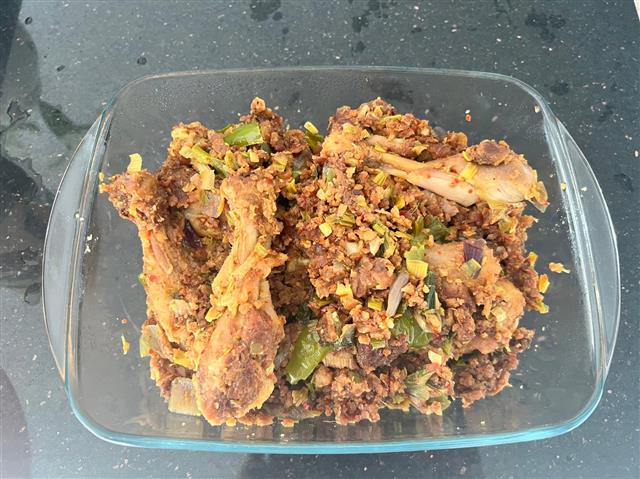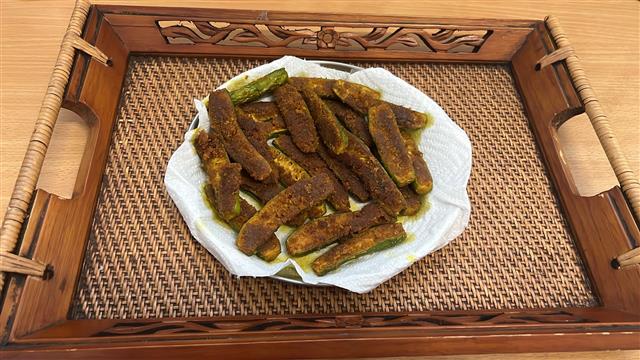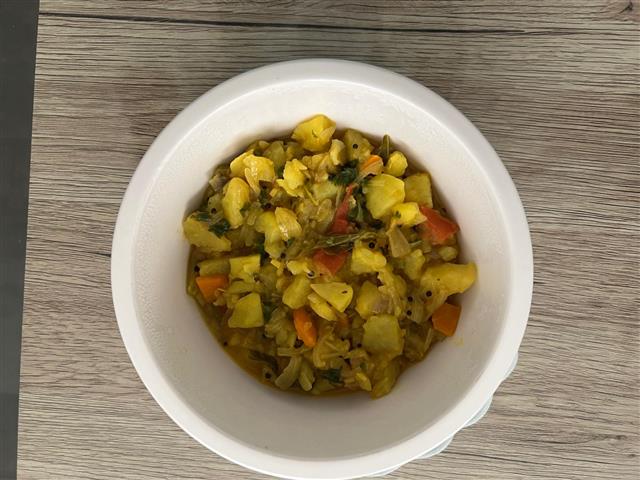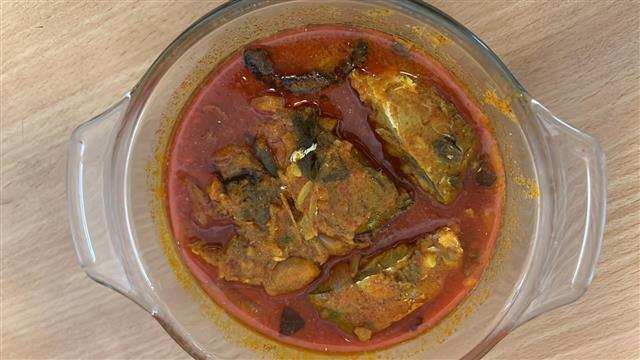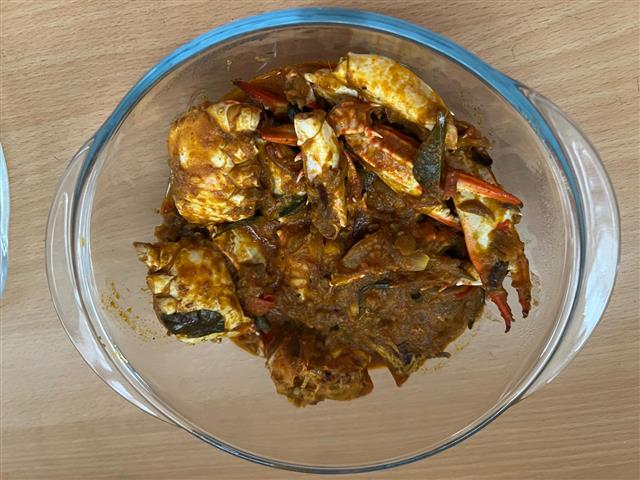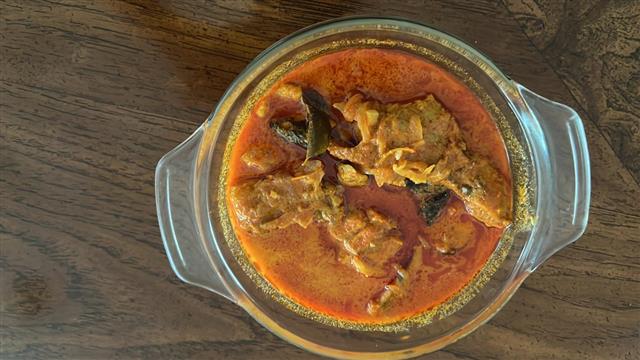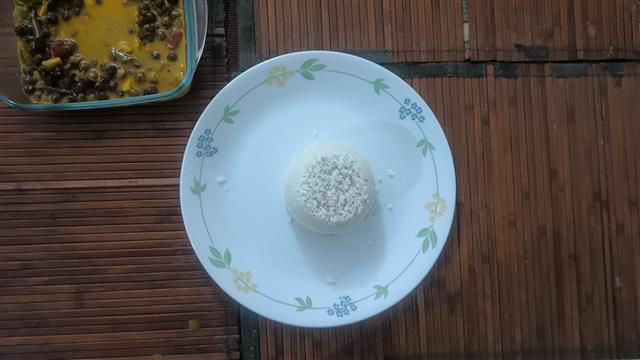
Pazha Manga Curry
(4 reviews)
Sweet, tangy, and soothing, Pazha Mango Curry is a traditional Kerala dish made with ripe mangoes, curd, and a gentle blend of spices.
Balancing sweet, sour, and spiced notes, this dish is a seasonal favorite. You will find it in Malayali kitchens during the summer when ripe mangoes are abundant.
Perfect for those who enjoy a mildly spiced curry with the comforting flavor of fruit and yogurt.
Ingredients
Directions
- Cook mango slices with a little chili powder and turmeric.
- In a mixer jar, beat thick curd with a pinch of jeera and 2 small onions.
- Mix the curd mixture with the cooked mango; do not boil.
- Season with mustard, uluva, chili, and curry leaves.
Cooking Tips
→ Use ripe but firm mangoes for best results; avoid overripe ones that may turn mushy.
→ Do not boil after adding curd to prevent curdling. Warm it gently if needed.
→ Use coconut oil for a more authentic Kerala flavor, especially during tempering.
→ Let the curry sit for 10–15 minutes before serving so the flavors come together.
How to Serve
→ Steamed matta rice (red rice) for the best pairing
→ Dosa or appam for a lighter and scoopable option
→ Pappadam or banana chips for texture
→ Potato Mezhukkupuratti (stir-fried veg) for a complete meal
The Story Behind Pazha Manga Curry
This Pazha mango curry brings back memories of mango season, when baskets of ripe fruits would arrive from relatives' orchards. The house would be filled with the scent of ripening mangoes. Sweet, warm, and inviting.
In the kitchen, my grandmother would slowly slice them with practiced hands, setting aside the best ones for curry and pickles. She said Mango Pulissery doesn't appreciate being rushed, and she was right.
Now, every time I make it, I think of that warm kitchen, the tangy-sweet taste, and how something so simple could bring back wonderful memories. What Is Pazha Mango Curry? Pazha Mango Curry is a classic Kerala dish made from ripe mangoes, curd, and a minimal blend of spices.
Unlike spicy or coconut-heavy curries, this dish is light, slightly sweet, tangy, and soul-soothing. The mango contributes a natural richness, while the curd lends a creamy body without heaviness. It is especially popular during summer, when mangoes are in abundance, and the cooling properties of curd are most welcome.
This curry holds a place in both everyday meals and celebratory spreads, offering a moment of comfort and nostalgia with each spoonful. In traditional Kerala Sadyas—the grand vegetarian feasts served on banana leaves—Mango Pazha Curry makes an appearance as one of the sweet-sour curries. Its cooling nature complements the hotter, drier dishes on the leaf and brings balance to the overall meal.
Though regional variations exist, the ripe mango version is particularly beloved for its unique combination of fruit and curd, bridging festive warmth with homely simplicity.
What Kind of Mango to Use?
Look for ripe, firm-fleshed mangoes—usually small, local varieties like Moovandan, Chandrakkaran, or Kilichundan. These mangoes tend to be less fibrous, slightly tart, and aromatic, which works perfectly in this kind of curry. Overripe mangoes may fall apart and overly sweeten the dish, while unripe ones will make it sour and flat. If using store-bought mangoes, choose those that are sweet but not stringy. You can even cube them or slice them into wedges depending on your preference.
Regional Variations Across Kerala → In northern Kerala (Malabar), mango pulissery is often spicier and may include garlic or a dash of roasted coconut paste. → In central regions like Thrissur and Ernakulam, the dish leans on the sweeter side. It's often served as part of Sadya during Vishu and Onam. → In southern Kerala (Alappuzha, Kollam), a thinner, more soupy version is common, where the mangoes are often small and left whole with the skin on. → Among the Namboothiri and Brahmin households, the curry is typically very light in spices, with a pronounced balance between curd and mango, and no onions.
Even the choice of mango varies—some leave the skin on, others use tiny native varieties. What never changes is the sense of comfort this curry brings, no matter where or how it's made.
Why Is Mango Curry Good for You?
Mangoes are a powerhouse of Vitamins A and C, and antioxidants. They aid in digestion, boost immunity, and uplift your mood naturally. Curd adds gut-friendly probiotics and helps balance body temperature in the summer. The spices used in mango curry—mustard, fenugreek, and jeera—not only add flavor but also help in digestion and prevent bloating. It's light, nourishing, and vegetarian, making it suitable for most diets and occasions.
Pazha Mambazha Curry Swap Tips If ripe mango is unavailable and you want to make it : • Use canned mango slices in water (not syrup). Rinse and drain well. • Use semi-ripe mango for a tangier profile; increase the sugar slightly. • Replace mango with pineapple or jackfruit for a variation with a similar sweet-sour balance. If curd is unavailable or you want a plant-based option: • Use plain, unsweetened vegan yogurt. • Cashew or almond yogurt works well if slightly thickened. • Coconut milk can be used, but the flavor will shift to a pachadi-like version.
Pro Tips for Perfect Results
→ Always allow the mango to cool down before mixing in the curd. Warm is fine, but never hot.
→ For extra smoothness, strain the curd before using or beat it well until lump-free.
→ Tempering must be done separately and poured on top—don't mix it into the pot too early, or it will lose its texture.
→ If the curry is too sweet, add a splash of lime juice or a pinch of salt to balance it out.
Pazha Manga Curry Variations
With Coconut Milk or Yogurt Instead of Curd Replace curd with thick coconut milk or yogurt. Avoid boiling like you would with curd. This gives the dish a silkier texture, but coconut can alter the flavor profile.
With Green Mango For a tangy twist, use slightly unripe mangoes. Omit added sugar. This results in a curry similar to manga pulissery but with more fruit chunks.
With Garlic and Ginger Add a crushed garlic pod and a slice of ginger to the tempering. This infuses the oil with depth and a slightly spicy undertone
Sweet Mango Pachadi Style Add 2 tablespoons of grated coconut, a pinch of mustard seeds, and green chili paste to the curd for a more pachadi-style finish.
Diet-Friendly Adaptations
• Low-Sugar Version – If your mango is sweet enough, skip the sugar altogether. You'll still get a naturally sweet curry.
• Vegan Version – Use plant-based yogurt or coconut milk for a dairy-free version.
• Low-Fat Version – Use low-fat curd and skip additional oil except for tempering. The dish still comes out flavorful with less fat
Storing & Reheating Tips
→ Refrigerate: Pazha mango curry keeps well for a day. After that, the curd may begin to separate and affect the taste.
→ Reheat Gently: Never boil. Warm it slowly on low heat, or place the container in a bowl of hot water to gently bring it to temperature.
→ Freeze: Don't freeze as this changes the curd's texture. The mango may also become mushy and watery after thawing.
→ Tip: If storing, keep the tempering separate and add it fresh just before serving for the best flavor.
Common Mistakes to Avoid
→ Boiling after adding curd – this is the most common mistake and causes the curry to split. Always cool the base first. This applies to all curd-based curries, including Moru Kachiyathu (use the search button on our site to find this delicious curd based dish).
→ Using fibrous mango leads to a stringy texture. Pick varieties known for smooth flesh.
→ Over-spicing the Pazha mango curry can overwhelm the natural sweetness. This dish is meant to be gentle on the tongue. Avoid too much chili or other masala.
→ Skipping tempering (the final touch of mustard, fenugreek, and curry leaves) adds both aroma and a depth of flavor essential to the dish.
Frequently Asked Questions
Can I use Fresh curd? Yes. Fresh, thick curd offers a smooth texture. For the sourness, add some lime or lemon juice.
Can I make it in advance? Yes, but it tastes best within a few hours of making. If preparing in advance, refrigerate and reheat gently.
Can I use raw mango instead of ripe? You can, but it changes the dish. Raw mango results in a much tangier version of Mango curry. Use sugar to balance if needed.
Equipment Needed
→ Small Saucepan – For cooking mango and warming the curry
→ Frying Pan – For tempering the spices
→ Blender or Mixer Jar – To beat curd, onions, and spices into a smooth paste
→ Wooden Spoon – For gently stirring without breaking mango pieces
→ Serving Bowl – A wide, shallow dish works well for presentation and portioning
